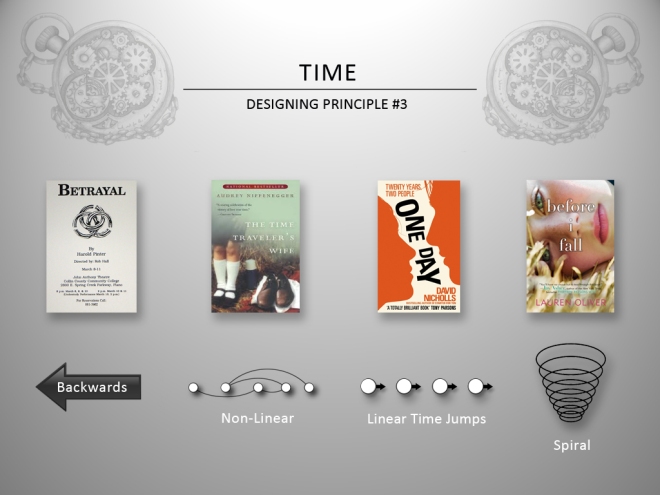We live our lives in a linear progression and that affects the way we think about narrative, how to live our lives, and what we value. Structurally and metaphorically time can be an interesting element to design with. Continuing our discussion on designing principles, lets see how the way we use time can become an organic structural framework.
Backward structures, like the film Memento or Pinter’s play Betrayal become causal mysteries. Charles Ramirez Berg notes that they “draw attention to causal connections, like forward moving structures, but … the narrative fuel is the search for the first cause of known effects.” The play Betrayal begins with a couple’s separation, and as we move back in time, we search for the moment that caused the relationship’s end.
But time can also be chopped up and moved around in any way that serves your story best. In The Time Traveler’s Wife the non-linearity reflects both the premise and unveils the importance of memory to our relationships. In the novel One Day, there’s a linear progression, but each chapter skips forward a year, forcing the reader to fill in the time between. In Groundhog Day and Before I Fall, the protagonists must repeat the same day over and over until they get it right. Even a ticking clock can create a structure; the TV show 24 takes a 24 hour ticking-clock and allots a single episode to each hour.
Does your novel span a day or many years? How does time affect your characters? Is it about looking back, moving forward, or the gaps between? Can the way you slice and dice time reveal another of level of content in your novel and is appropriate for your novel?
Up Next: Designing Principle #4 – Community
Want to know more about designing principles? Try these links:
- What is a designing principle?
- Designing principle #1: A character’s mental state
- Designing principle #2: Setting and environment




Great post!! My novel takes place in about ten days, so I have a ticking clock element. I’ve always loved books with a strong time element. Loved Before I Fall and The Time Traveler’s Wife. Loved Memento. I admire authors who have such a great command of story that they can leap back and forth and still help us see the progression.
Time is really fascinating. I love the short story collection/novel “Einstein’s Dreams” by Alan Lightman. It explores how different interpretations of time effect how we act and who we are as people. I really think our experience of time changes what we value. I love books that explore this concept and use structure as content to do so!